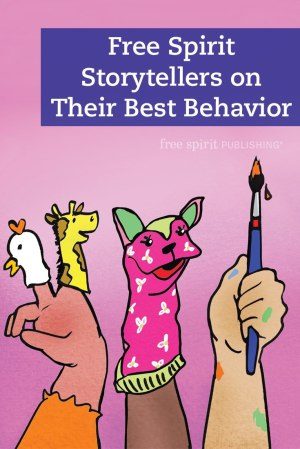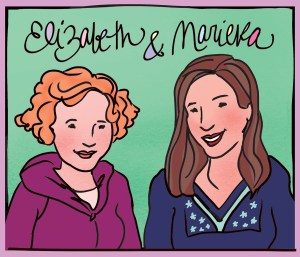By Elizabeth Verdick and Marieka Heinlen, author and illustrator of the Best Behavior® series
 Storytelling is at the heart of being human—and it starts at birth. We share stories as we talk to our babies, sing to them, and read to them. They grow rich in stories, and once children are verbal, they are eager to share their own tales, eventually writing and drawing them on paper. Storytelling helps children better understand the world, develop empathy, and grow up with greater knowledge and confidence. As an author/illustrator team, we’re grateful that storytelling—via words and art—is our daily work, our way to reach out to readers all over the world. Together, we aim to make books that serve as “mirrors and windows,” helping children build their own social and emotional identities while offering views into other children’s feelings and experiences. We think it’s the best job in the world!
Storytelling is at the heart of being human—and it starts at birth. We share stories as we talk to our babies, sing to them, and read to them. They grow rich in stories, and once children are verbal, they are eager to share their own tales, eventually writing and drawing them on paper. Storytelling helps children better understand the world, develop empathy, and grow up with greater knowledge and confidence. As an author/illustrator team, we’re grateful that storytelling—via words and art—is our daily work, our way to reach out to readers all over the world. Together, we aim to make books that serve as “mirrors and windows,” helping children build their own social and emotional identities while offering views into other children’s feelings and experiences. We think it’s the best job in the world!
Over the years, parents and teachers have asked us, “How do you make the books? How do you work together?” We’re glad you’ve asked! We thought it would be fun to share the story of how we collaborate.
 Elizabeth: Most of the books I’ve published are nonfiction with a focus on children’s social and emotional needs. You might know of the two series that Marieka Heinlen and I work on together: Best Behavior® and Toddler Tools®. Our main audience is toddlers, but many of our books have been adapted into lengthier versions for preK to grade 3. I love collaborating on these books, but I also write children’s fiction and have learned that most often authors and illustrators work separately—never even meeting! Thttps://www.elizabethverdick.com/book-series/best-behavior/he book’s editor is the go-between, and if an author is lucky, she will get to see some preliminary sketches. But that’s it until the full-color illustrations are placed with the text. At that point, the author finally sees how the words and images work together. There’s so much that goes on behind the scenes: laying out the narrative, determining the story’s climax, creating character consistency on the page, identifying the color palette, choosing fonts, and completing page designs—all of which will be a surprise for the author. (Talk about suspense!) From the author’s perspective, it can feel like you’re waiting so long that spider webs could cover you by the time it’s all finished. Then—years after signing a book contract—you get a present in the mail: your completed book.
Elizabeth: Most of the books I’ve published are nonfiction with a focus on children’s social and emotional needs. You might know of the two series that Marieka Heinlen and I work on together: Best Behavior® and Toddler Tools®. Our main audience is toddlers, but many of our books have been adapted into lengthier versions for preK to grade 3. I love collaborating on these books, but I also write children’s fiction and have learned that most often authors and illustrators work separately—never even meeting! Thttps://www.elizabethverdick.com/book-series/best-behavior/he book’s editor is the go-between, and if an author is lucky, she will get to see some preliminary sketches. But that’s it until the full-color illustrations are placed with the text. At that point, the author finally sees how the words and images work together. There’s so much that goes on behind the scenes: laying out the narrative, determining the story’s climax, creating character consistency on the page, identifying the color palette, choosing fonts, and completing page designs—all of which will be a surprise for the author. (Talk about suspense!) From the author’s perspective, it can feel like you’re waiting so long that spider webs could cover you by the time it’s all finished. Then—years after signing a book contract—you get a present in the mail: your completed book.
My work with Marieka is . . . a whole different story. Our bookmaking process in educational publishing doesn’t have so many surprises because Marieka and I are involved in almost every stage of a book’s development. Together, we figure out how the words will fit on each page and how the images will complement the text. We brainstorm ideas for book covers, we talk about scenes that will best show a diverse community of children and adults, and we use our knowledge of all the previous books in our series to make sure we keep the material fresh but also compatible with earlier works. The best thing about collaborating on new projects with Marieka is that we’ve known each other for more than two decades, and we both live in the Twin Cities—that face-to-face contact and history helps keep our creativity flowing. We’re both moms, we both love kids, and we both feel lucky to have the opportunity to use positive language and images to help our readers handle the social and emotional ups and downs of growing up. It’s hard work—but mostly it’s fun, fulfilling work.
We can’t wait to get started on new projects, and we love when our readers send us ideas. Every week, I get emails from parents telling me about the challenges they face raising their kids: My child won’t stop sucking her thumb! My toddler insists on dressing himself without any help and has a tantrum when I even try to get his pants on. Can you write a book about not spitting? My own children are well past toddlerhood, but they have always inspired my creative work and storytelling. These days, I have lots of young nephews who keep inspiring me with their busy, curious, hilarious, and challenging antics. I write nonfiction and fiction with them in mind. Storytelling is my way of connecting with them from far away.
Marieka: Elizabeth’s and my books are teaching books. Children learn visually from the very beginning: Where am I? Who is taking care of me? Where do I get food? When do I go to sleep? When we teach toddlers, it is so important to combine the visuals with words. When I first started illustrating the Best Behavior series, I instinctively drew dark lines and used saturated colors to capture the attention of busy little readers. It was always important to portray every kind of child I could imagine, so our readers could find themselves in each book. I also researched environments, from urban or rural settings to child care centers and homes, since we wanted each child to see familiar surroundings. All the Best Behavior books present a common challenge or milestone for children; the Toddler Tools series, on the other hand, focuses on daily routines and transitions that young children must learn to help organize their world. Elizabeth creates text young children can relate to, and I work to make art they can identify with. I like to think that between the words you read and the art you see, you get a full understanding of each social-emotional topic through a child’s eyes.
Elizabeth and I met working at Free Spirit Publishing, where I was a designer and Elizabeth an editor. We had been writing and illustrating for years and were enthusiastic about broadening our skill sets. Our ideas flowed easily out of a common language we had learned from working closely together on other books and marketing materials. When we started collaborating as storytellers long ago, we would look at Elizabeth’s text together and come up with ideas about how to show the reader what was happening. Book after book, our process became more streamlined: Elizabeth knew my style and I understood how to make her words come alive in scenes without too much back-and-forth.
As an author-illustrator team, we were creating a world together, one that all children could find themselves in. Elizabeth imagined scenarios where children learned life lessons, and she described feelings and actions in simple, clear messages. Her words were pared down to just what a young child could grasp about emotional growth while still being fun to read, with a singsong cadence and easy flow. I took her words and created bright and bold pages, bursting with diversity and expression. I worked hard to represent all kinds of people, homes, neighborhoods, and educational settings. Whenever possible, Elizabeth made sure I got lots of animals and pets in there too!
We are very lucky: There is a never-ending bounty of social-emotional skills to teach children through our books. We hope to keep telling stories for years to come.
Elizabeth Weiss Verdick has written children’s books for kids of all ages, from toddlers to teens. Elizabeth loves helping kids through her work as a writer, an editor, and a mentor to children and teens. She lives in Minnesota where she plays traffic cop for her many furry, four-footed friends.

Marieka Heinlen received her BFA at the University of Wisconsin, Madison, and also studied at Central Saint Martins College of Art and Design in London. She launched her career as an award-winning children’s book illustrator with Hands Are Not for Hitting and has illustrated all the books in the Best Behavior and Toddler Tools series. Marieka focuses her work on books and other materials for children, teens, parents, and teachers. She lives in St. Paul, Minnesota, with her husband, son, and daughter.
“Free Spirit Storytellers on Their Best Behavior” originally appeared at freespiritpublishingblog.com. Copyright © 2020 by Free Spirit Publishing. All rights reserved.

